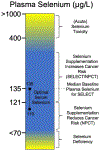Selenoproteins and tRNA-Sec: regulators of cancer redox homeostasis
- PMID: 37716885
- PMCID: PMC10843386
- DOI: 10.1016/j.trecan.2023.08.003
Selenoproteins and tRNA-Sec: regulators of cancer redox homeostasis
Abstract
In the past two decades significant progress has been made in uncovering the biological function of selenium. Selenium, an essential trace element, is required for the biogenesis of selenocysteine which is then incorporated into selenoproteins. These selenoproteins have emerged as central regulators of cellular antioxidant capacity and maintenance of redox homeostasis. This review provides a comprehensive examination of the multifaceted functions of selenoproteins with a particular emphasis on their contributions to cellular antioxidant capacity. Additionally, we highlight the promising potential of targeting selenoproteins and the biogenesis of selenocysteine as avenues for therapeutic intervention in cancer. By understanding the intricate relationship between selenium, selenoproteins, and reactive oxygen species (ROS), insights can be gained to develop therapies that exploit the inherent vulnerabilities of cancer cells.
Keywords: ferroptosis; oxidative stress; reactive oxygen species; redox; selenium; selenoprotein.
Copyright © 2023 Elsevier Inc. All rights reserved.
Conflict of interest statement
Declaration of interests None are declared by the authors.
Figures





References
-
- Hanahan D, Weinberg RA. Hallmarks of Cancer: The Next Generation. Cell 2011; 144:646–674. - PubMed
-
- Hanahan D Hallmarks of Cancer: New Dimensions. Cancer Discov 2022; 12:31–46. - PubMed
-
- Szatrowski TP, Nathan CF. Production of large amounts of hydrogen peroxide by human tumor cells. Cancer Res 1991; 51:794–798. - PubMed
Publication types
MeSH terms
Substances
Grants and funding
LinkOut - more resources
Full Text Sources
Medical
Miscellaneous

